|
summary of construction under phase I and II includes: 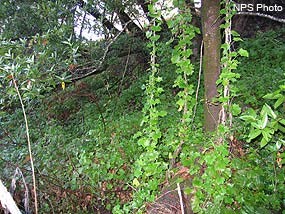
The presence of invasive or non-native plant species can pose a real threat to the viability and integrity of native or natural vegetation communities. These species can not only displace individual native species, thereby increasing the potential for their extinction, but change entire landscapes, such as the apparent large-scale conversion in California from perennial bunchgrass-dominated to non-native annual-dominated grasslands over the last few centuries that has supposedly now given the state its golden hued hills. In addition, invasive and non-native species can alter the physical and biological processes of ecosystems in ways that are sometimes hard to discern, but that have tremendous impacts on food web and population viability dynamics. Within the Project Area, the presence of invasive non-native plant species was documented through vegetation mapping, although the specific location and areal extent of occurrences of specific "problem" species were not necessarily mapped unless the occurrence was relatively large (e.g., stands of eucalyptus; Parsons and Allen 2004). Invasive species were defined as those ranked by the California Invasive Plant Council (CalIPC) or by the Seashore as a significant threat to native ecosystems of California and/or the parks. CalIPC relies on a categorical system of ranking the seriousness posed by invasive species, with "High" comprising the most invasive ones and the list, "Limited," the least invasive. CalIPC just recently revised its list and ranking system since the last version was introduced in 1999. The Seashore also manages a comprehensive weed removal program that has targeted a number of this CalIPC species, but that has focused on some very high priority species that include pampas grass (Cortaderia spp.), French broom (Genista monspessulana), Scotch broom (Cytisus scoparius), cape ivy (Delairea odorata), eucalyptus (Eucalyptus spp.), European dune grass (Ammophila arenaria), and iceplant (various species). The Park Service is directed to manage and eradicate invasive plant and animal species that "interfere with natural processes and the perpetuation of natural features, native species, or natural habitats…" (NPS 2006; Section 4.4.4.2). Approximately 49 CalIPC invasive species occurred in the Project Area (Parsons and Allen 2004). Although the number of species is relatively high, the number of occurrences and/or areal extent of most of these plants remained comparatively low (Table 2; Parsons and Allen 2004). Table 2. Acreage of the Dominant Invasive Non-native Plant Species in the Giacomini Wetland Restoration Project Area
Of the 49 species, nine were on the "High" List, which includes the most invasive and widespread invasive species. The most common "High" threat species in the Project Area were fennel (Foeniculum vulgare) and Himalayan blackberry (Rubus discolor), with Himalayan blackberry acreage in the Project Area totaling 9.36 acres (Table 2). Himalayan blackberry represents a common riparian understory or shrub species, although California blackberry (Rubus ursinus) appeared to have a higher percent cover (Parsons and Allen 2004). Fennel primarily establishes in Ruderal and Disturbed habitats along levees, berms, and other areas. Only two (2) patches of pampas grass (Cortaderia jubata) have been observed in the Project Area, with acreage totaling less then 0.01 acres (Table 2). Some efforts at eradicating at one of these patches were undertaken under the Seashore’s Exotic Management Plan even prior to construction, with the rest removed in 2008. Cape ivy (Delairea odorata) and English ivy (Hedera helix) occurred in the riparian habitat adjacent to Sir Francis Drake Boulevard in scattered patches totaling less than 0.4 and 1.8 acres, respectively (Table 2), but, due to these species' invasiveness, their presence represents a threat, because of the proposed project's objective of increasing riparian habitat. 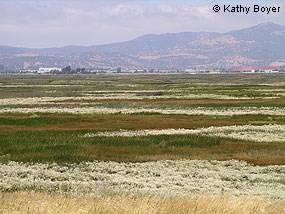
Since the EIS/EIR was published, the Park Service has found some additional invasive or weedy species of concern. Perhaps, the biggest threat comes from perennial pepperweed (Lepidium latifolium), a salt-tolerant member of the mustard family that can invade and rapidly take over mid- to high-elevations of marshes and that is rapidly taking over many high marsh ecotonal and levee areas in San Francisco Bay marshes. In 2008, perennial pepperweed was found in both the East and West Pastures of the Giacomini Ranch. In both cases, the areas frequently receive flood overflow from either Lagunitas Creek or Fish Hatchery Creek, suggesting that seed and propagule sources may have come into the Project Area from upper watershed sources during flood events. In addition, Park Service and Audubon Canyon Ranch staff have also found other occurrences of pepperweed near Walker Creek Marsh, upstream areas of Walker Creek, and the northern end of the undiked marsh near Inverness. Park Service staff attempted to remove these plants several times, but it is notoriously difficult to treat due to copious seed and rhizome production and a seemingly extended flowering season. Retreatment of these areas, which total less than 0.1 acre in size, will need to be vigorously pursued in future years. In addition to pepperweed, Park Service staff also found several small patches of distaff thistle (Carthamus sp.), which were removed. 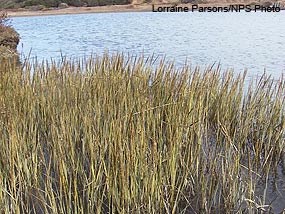
One invasive estuarine species that has NOT been documented in the Project Area is Atlantic cordgrass (Spartina alterniflora) or the hybrids that this native of the East and Gulf coasts creates with the cordgrass that is native to the Pacific coast, Spartina foliosa. The native cordgrass species, Pacific cordgrass, has been designated a Species of Regional Concern due to the fact that non-native, invasive Atlantic cordgrass hybrids have been rapidly displacing it in San Francisco Bay. The 2004 Invasive Spartina Project (ISP) found, in San Francisco Bay, hybrid population had spread to 734 net acres, up 52 percent from the 2001 estimate of 482 net acres (ISP 2004). Atlantic cordgrass and hybrids have also been discovered in Drake’s Estero, and the Seashore has been vigorously treating them through tarping to try and eliminate this threat to outer coast populations of Pacific cordgrass. ISP has been conducting surveys in Tomales Bay and the Project Area for Atlantic cordgrass and hybrids every year during recent years and has yet to discover any, although at least two occurrences of dense-flowered cordgrass (Spartina densiflora) have been recorded historically within the Bay. Because funding for invasives removal was limited, the Park Service focused its efforts on the High Threat species. In addition, for some of the species such as Himalayan blackberry, park staff further assigned priority status to specific occurrences or "patches" based on a number of factors, including 1) how accessible the area would after construction was complete and the levees were gone; and 2) the location of the occurrence and whether these patches would have a high potential to re-infest cleared or currently uninfested areas. With the exception of the efforts referenced above, all of the invasives removal efforts occurred under Phase II. Invasives removal was conducted by several contractors, including Marin Conservation Corps of San Rafael, Calif., Great Tree Tenders of Ukiah, Calif., and Sonoma-Marin Arborists. See attached graphics for maps of invasives removal areas. In January 2008, the first treatment of cape ivy—all of which occurs in the riparian habitat along Sir Francis Drake Boulevard and Bear Valley Road—was conducted by Marin Conservation Corps crews. Cape ivy is treated in the winter, when many of the other trees have lost their leaves, making it easier to discern and remove the evergreen cape ivy. Approximately 0.4 acre of cape ivy was removed, with retreatment of this area performed in December 2008. Subsequent treatments will be performed in future years, funding permitting. 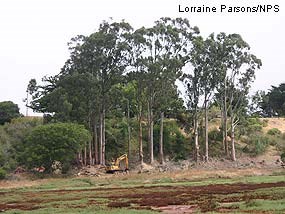
In August 2008, a separate contractor, Marin-Sonoma Arborist, removed a large portion of the non-native Eucalyptus trees on the Giacomini Ranch property near the Martinelli Ranch, which is part of Golden Gate National Recreation Area. Thanks to a donation by a local member of the Point Reyes community, more than 60 medium- and large-sized Eucalyptus trees were felled and, when possible, chipped and evenly redistributed within the work area. Smaller-diameter trees were cut by Park Service staff. In November, erosion control blanket and other soil stabilization measures will be installed to minimize surface run-off of soils during the rainy season. This removal of these invasive non-native trees begins the process of restoring more than 0.6 acre of mesic coastal scrub and oak woodland/savannah habitat. It will also contribute to improving conditions for riparian habitat along the former Tomasini Creek channel (now Tomasini Backwater Slough) by decreasing the amount of groundwater and surface water uptaken by Eucalyptus trees, which are heavy water users, according to Jordan Reeser of the Seashore’s Fire Management Division, who headed the removal project. By fall 2008, many young native California blackberry and coyote brush were already establishing in the former Eucalyptus area, along with the French broom, which will require additional treatment in future years. 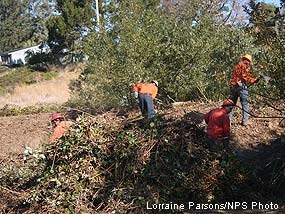
Perhaps, the largest invasives removal effort for this project came from removal of Himalayan blackberry, which was the most dominant non-native species in the Giacomini Ranch. Because there was not enough funding to remove all of the Himalayan blackberry, removal efforts were concentrated on the top priority occurrences and patches, namely, those that occurred in areas where access would be difficult in the future. Approximately 1 acre of stand-alone Himalayan blackberry patches and 1.55 acres of patches where blackberry was intermixed with willow were removed in 2008. Most of these patches occurred in the East Pasture; along Lagunitas Creek in the southern portion of the East Pasture; and along the upper to middle portions of Tomasini Creek and the new Tomasini Backwater Slough. Retreatment of these areas will need to be conducted annually for at least three to five years, funding permitting, to ensure successful eradication. Because blackberry often covered large expanses of riparian habitat areas and had eliminated native plant cover, active revegetation of these areas will be conducted when retreatment efforts appear to be successful to ensure that non-native blackberry is replaced with a diverse mix of native riparian trees and shrubs. As noted earlier, in most cases, saltwater will help to convert the pastures, which are dominated by non-native grasses and herbs, to native vegetation communities. However, at the upper extent of where tides will reach, conversion will be complicated by the fact that these high marsh or upland ecotone areas are less exposed to saltwater or inundation. These high marsh and upland ecotone are more susceptible to invasion by weedy or invasive non-native species, particularly when soils are very nutrient-rich. 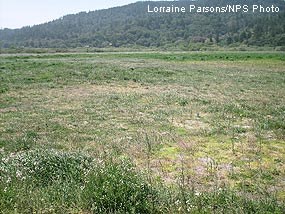
In most areas of the East Pasture, manure was only lightly spread, however, concentrated manure slurry was often either piped out or trucked out and disposed of in a 13-acre pasture area located in the southern portion of the East Pasture. Based on results from computer hydraulic modeling of expected tidal ranges in the restored Project Area (KHE 2006), this Manure Disposal Pasture is located at the upper extent of tidal influence and will not be significantly affected by dramatic increases in saltwater inundation or soil salinities. In recent years, this Manure Disposal Pasture has been dominated by an incredibly diverse mix of weedy and invasive species, including poison hemlock (Conium maculatum), bull thistle (Cirsium vulgare), and, as discovered recently, perennial pepperweed. 
In 2007, under Phase I, the Park Service and PRNSA excavated the 13-acre Manure Disposal Pasture by 1 to 2 feet (see Phase I Components - Detailed Description). While elevated nutrient concentrations extended below this depth, the surface soils appear to be the "hottest," and funds for scraping and disposal of nutrient-rich soils were limited. Based on soil testing conducted in 2008, this excavation may have reduced total nitrogen concentrations by as much as 36% (NPS, unpub. data). To reduce cover of some of the non-native species in the Manure Disposal Pasture, mowing was conducted in early summer 2008 to try and cut down as many weeds as possible while they were flowering, but before seed was set. Mowing was delayed due to the fact that many grassland bird species were nesting in nearby pastures and on the perimeter of the Manure Disposal Pasture. Should funds (and nesting birds) permit, mowing or weed-whipping will be conducted in the late spring every year to try and reduce the seed load for these invasive and weedy ruderal species. In addition, there may be some attempt to increase salinities in this High Marsh/Upland Ecotone area through saline irrigation or salt treatments. Some testing of the potential efficacy of direct salt application was conducted in 2007–2008, but results from this research project have not been assessed yet. Once ruderal cover drops due to mowing, saline irrigation, or both, active revegetation would be conducted in this area. summary of construction under phase I and II includes: |
Last updated: October 13, 2022
